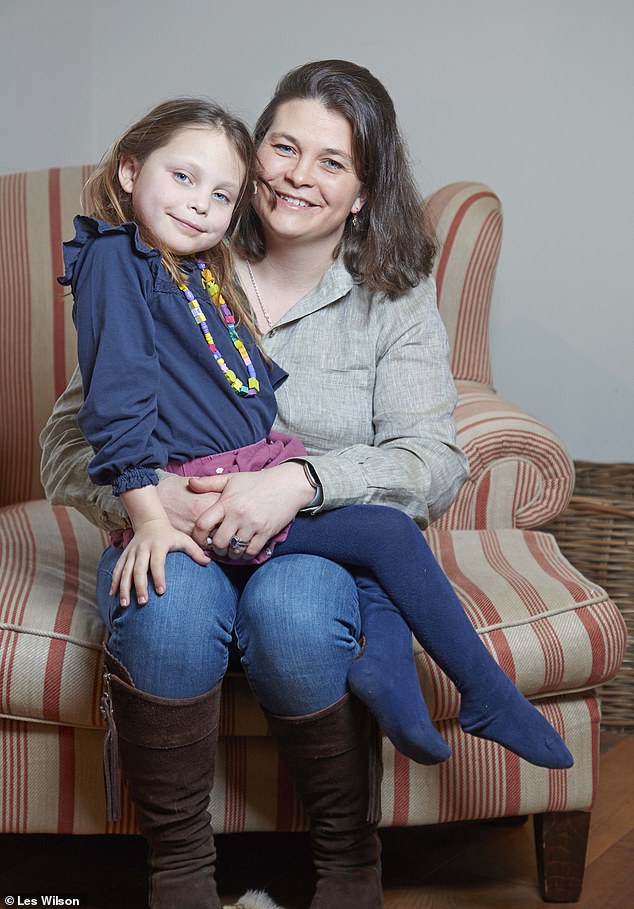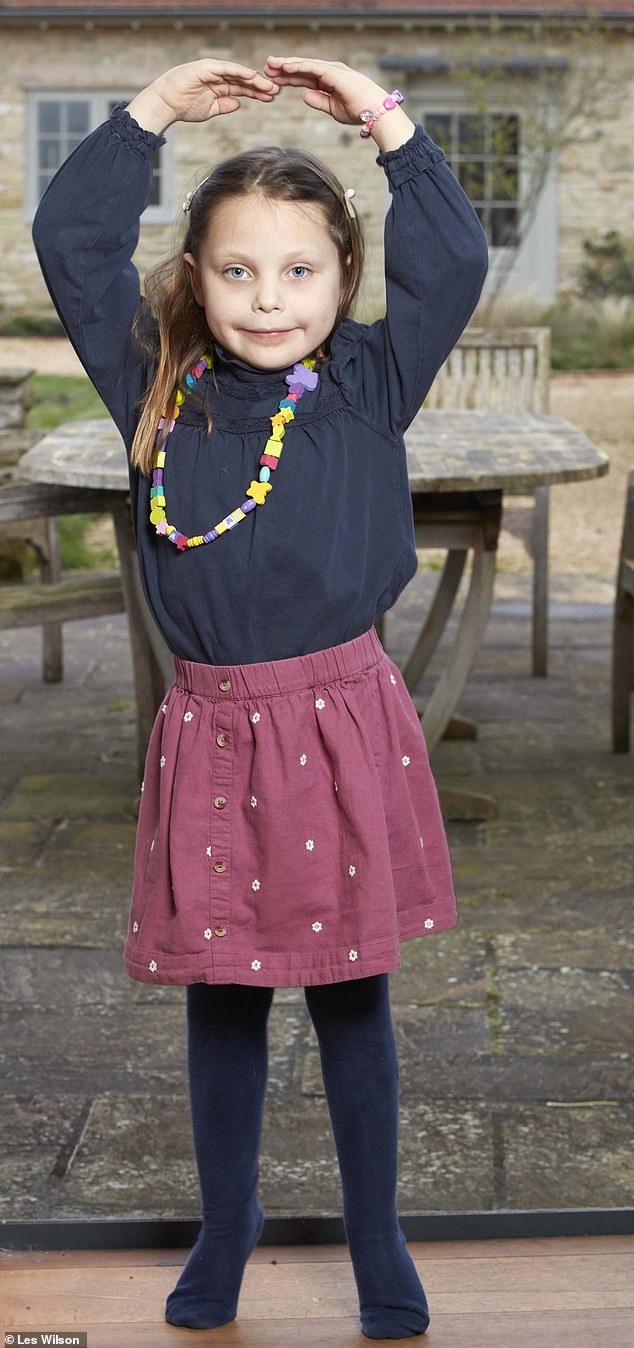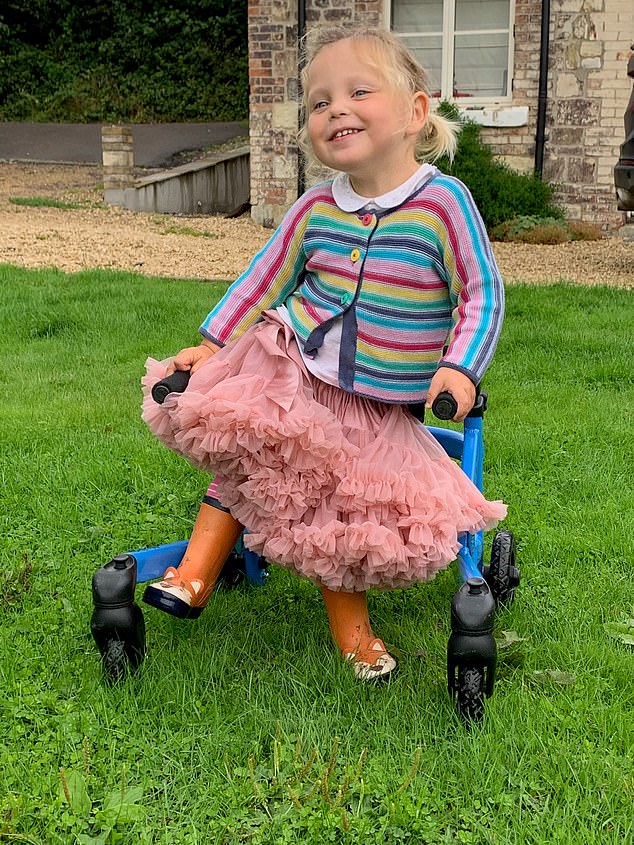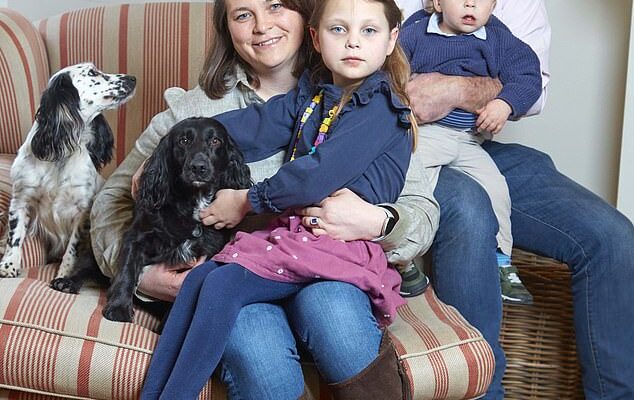Anouk Howes loves swinging fearlessly from climbing frames and playing mummies and babies with her one-year-old brother Willem.
Independent and sassy, the six-year-old is ‘hardly a wallflower’, laughs her mother Sophie, 35, who is PA to a sculptor.
Yet when Sophie and her husband, Mike, 37, chief executive of a tech company, from Wiltshire, watch Anouk walk around the house, they can’t help but wonder how many more steps she’ll be able to take.
Anouk has a genetic condition, spinal muscular atrophy (SMA), which affects the muscles, causing progressive wasting and weakness.
They have a wheelchair which Anouk doesn’t yet use, but Sophie and Mike know that will change sometime soon.
Anouk Howes, six, with her mother Sophie, father Mike and brother Willem, who has been diagnosed with SMA, a genetic condition which affects the muscles, causing progressive wasting and weakness

Children are born with SMA if both parents have a faulty gene that causes the condition — one in 40 is a carrier

In the past five years treatments have been approved for use on the NHS that can stop the disease in its tracks. The catch is that they need to be started within the first weeks, or even days, of life
What is agonising for them is that this might have been avoided — with a simple blood test that many other countries already offer.
Children are born with SMA if both parents have a faulty gene that causes the condition — one in 40 is a carrier.
Prior to 2019, babies with SMA type 1 often wouldn’t survive until their second birthday, and infants with the milder type 2 would never walk, facing life in a wheelchair as well as multiple surgeries and respiratory infections.
But in the past five years treatments have been approved for use on the NHS that can stop the disease in its tracks.
The catch is that they need to be started within the first weeks, or even days, of life.
As babies in the UK aren’t tested for SMA, for many, such as Anouk, the diagnosis comes too late for this.
Now campaigners and senior experts are pushing for that to change.
SMA stems from a fault with the SMN1 gene, which should stimulate the production of SMN protein that maintains the health of the nerve cells involved in the transmission of signals between the brain and spinal cord and the muscles, which control movement.
In the absence of this protein, these nerve cells (called motor neurons) die off and so the muscles — particularly in the legs, chest and arms — don’t get the message to move, and so waste away.
The nerve cells die off so swiftly that even short delays in treating SMA can make the difference between a baby growing up able to walk and develop normally, or becoming severely disabled.
‘It is a matter of days,’ says Laurent Servais, a professor of paediatric neuromuscular diseases at the University of Oxford.
‘Each day motor neurons die and reduce the probability of a child being symptom-free.’
With SMA type 1, 95 per cent of motor neurons can be destroyed before the age of six months.
However, there are three treatments that stop the disease progressing — if given in time — that have been approved on the NHS.
The first, Spinraza, is injected around the spine every four months, and works by encouraging the body to produce more SMN protein.
Zolgensma, given as a one-off injection, carries a healthy copy of the SMN1 gene to the brain and nerve cells, where it delivers the SMN protein.
And Evrysdi is taken as a liquid, daily, for life. It also works by increasing production of the SMN protein.
The drugs can be life-changing but only if started within weeks of birth.
Experts say that if SMA was included in the newborn blood spot test — where a blood sample taken with a heel-prick at five days old is examined for nine genetic conditions including cystic fibrosis — infants with SMA could receive one of these treatments in time.
Yet the UK National Screening Committee (NSC), the body that advises government and the NHS about screening programmes, decided not to add SMA to the newborn screening programme in 2018 after concluding there wasn’t evidence to support the move.
When Anouk was born in March 2018 all appeared well: alarm bells only started to ring 15 months later after she developed a strange gait.
By the time she was diagnosed in October 2019 the critical window for treatment had long closed and her strength and mobility nose-dived under her terrified parents’ eyes.
‘I torture myself with the ‘what ifs’,’ says Sophie.
‘If she’d been tested at birth and I’d have got the drug to her earlier, could that have changed her life? Would she be faring better than she is now? She might be able to skip, run and get up from the floor on her own.’

Symptoms usually become apparent between seven and 18 months old, when youngsters start needing help to stand or walk, and their arms and legs become weaker. Anouk was around 15 months old when her parents noticed something was not right with Anouk
SMA isn’t a single disease, it’s a broad spectrum of conditions, explains Professor Servais.
‘The most severe, SMA type 1, accounts for 60 per cent of cases. Babies with type 1 are born looking healthy, they pass their health visitor checks and everything seems fine,’ he says.
‘But within the first six months they will develop symptoms such as weak and floppy limbs and neck.’
They will also have problems with moving, eating, breathing and swallowing and are unable to raise their heads or sit without support.
‘It is an extremely serious condition and babies will often die within five months of diagnosis,’ Professor Servais says.
‘Then 25 per cent have the milder form, SMA type 2. These babies will be able to sit up but they won’t walk.
‘They might develop scoliosis, a curvature of the spine [as they lack strong back muscles], and suffer from respiratory infections.’
Symptoms usually become apparent between seven and 18 months old, when youngsters start needing help to stand or walk, and their arms and legs become weaker.
As well as scoliosis, patients can develop tremors in their fingers and hands.
‘With good respiratory medication, management of infection, good nutrition and a good wheelchair, they can live until adulthood,’ says Professor Servais.
A third group — about 15 per cent — have SMA type 3. ‘These patients will be able to walk, but at the age of three parents will notice they have difficulty with this and with climbing stairs,’ says Professor Servais.
‘Most of these children will lose the ability to walk at around the age of ten. They will have a normal lifespan but many will be wheelchair-bound from the second decade,’ he says.
It was in June 2019, when 15-month-old Anouk started toddling around the house holding on to her walker, that the Howes first noticed something wasn’t right.
‘She walked with straight legs and never bent down to pick anything up,’ Sophie recalls.
‘She couldn’t pull herself up to stand either.’
Sophie took Anouk to see the GP twice, as well as a local physio. Both reassured her that all was well.
‘They said it’s nothing to worry about, she’s probably slow or a bit lazy and, by the time she’s two, she’ll be fine,’ says Sophie.
Then Sophie’s mother Caroline, who is a GP, noticed that Anouk’s crawling was getting slower.
‘Where she used to be able to crawl up the stairs, she started using her head as a balance. She’d put her hands up, then her head, before pulling her body up,’ says Sophie.
Fortunately, Anouk had an appointment at the Nuffield Orthopaedic Centre in Oxford for July 2019, to address an entirely different complaint.
Born with hip dysplasia, where the ball and socket joint of the hip doesn’t form properly, Anouk had to wear a harness as a baby, and was attending sessions with her physio until the age of two.
At this routine visit, Sophie raised Anouk’s deteriorating mobility and the physio told her: ‘I have a small niggle that it might be something neurological.’
Worried, Sophie took Anouk to a private paediatric neurologist in London in September 2019, where her reflexes were tested.
‘The consultant said, ‘Without a blood test I can’t diagnose her but I believe she has spinal muscular atrophy’,’ says Sophie.
‘I didn’t know what SMA was so I started Googling, which is terrifying as it’s a horrible condition.’
In October 2019, a blood test confirmed that Anouk had SMA type 2. Dr Anne-Marie Childs, a consultant paediatric neurologist at Leeds Teaching Hospitals NHS Trust, says the disease is rare and doctors may go through their career never seeing a case, so don’t know what to watch for.
‘This is why it’s important to have newborn screening,’ she adds. ‘But any baby who is bright and alert but isn’t moving or feeding, or has an odd pattern of chest movement, needs to be seen urgently by someone who has the knowledge and capacity to pick up a diagnosis of SMA.’
For a pilot study, launched in 2021 by the University of Oxford, SMA was added to the newborn blood spot test, and thousands of babies have been screened for it at birth in hospitals across the Thames Valley and elsewhere.
The aim was to generate evidence to persuade the UK NSC to recommend adding SMA to the newborn blood spot test.

Anouk Howes as a newborn with mum Sophie and father Mike. The couple now worry how much longer their daughter will be able to walk
The trial is ongoing, but already it has identified one baby who is now receiving prompt treatment for the condition.
Yet the findings have not been enough to convince the UK NSC, which will conduct a larger trial of its own — but when it will begin and how long it will last have yet to be revealed.
A spokesperson for the Department of Health and Social Care said only: ‘The UK National Screening Committee is reviewing the case for newborn screening.’
Campaigners fear this bigger trial could run for several years, leading to unnecessary delays.
‘This is a safeguarding issue for all the kids in this country,’ says Professor Servais.
‘We could go much faster.’ Indeed, the UK is looking increasingly like an outlier, as the majority of European countries, including Sweden, Norway, Poland, the Netherlands, Portugal, Germany, Belgium, Switzerland and Ireland, now screen for SMA at birth.
‘Ukraine implemented newborn screening in the middle of the war,’ says Professor Servais.
A study published in the journal JAMA Paediatrics earlier this year, involving 234 children with SMA born between January 2018 and September 2021 in Germany, Austria and Switzerland, found that of 44 children who’d been tested for SMA as newborns as part of a German pilot scheme (prior to it being added to screening in 2021), 91 per cent could sit independently within 18 months.
However, in the 190 children who were tested later, once symptoms appeared, only 74 per cent reached that milestone.
Professor Servais says that while working in Belgium, his team ‘started newborn screening in March 2018 and since then we’ve made the disease disappear, as we treat the patients at birth’.
Now experts and campaigners can only push for more research into treating and managing SMA.
The Howes family has set up a charity, ACE SMA, to raise funds to study the benefits of bespoke physiotherapy for children with SMA, including offering it in their homes, teaching parents the necessary skills and providing the right equipment.
The study, which will be run by Professor Servais, is expected to start this month.
‘Many children with SMA can’t walk, so they need physio to help keep their arms strong enough to get them in and out of a wheelchair,’ says Sophie.
‘Children with SMA also often need chest physio to prevent respiratory illnesses.
Their chest muscles are weaker so they find it harder to cough and remove phlegm from their lungs.’
On a personal level, Anouk’s diagnosis has involved re-evaluating so much of their lives.
The couple love sport — Mike played rugby and, as a teenager, Sophie played lacrosse for England — and they hoped it would become a key part of family life.
‘We had to accept that she wouldn’t be able to do the things we loved, and might not be able to do the things that we find easy, such as getting out of bed on her own,’ says Sophie.
‘There’s a grieving process for the life we assumed she’d have.’
Having another child was one of their dreams. ‘I’m one of four children and Mike is one of three,’ says Sophie.
‘I loved the idea of a big family with kids running around together and with their cousins.
‘I was desperate for Anouk to have a sibling. We felt if we’re not around any more, she’ll have someone by her side to help her.’
They conceived Willem via IVF, using genetic screening to ensure he wouldn’t have SMA.
‘Anouk adores him but as she gets older she’s becoming more aware of her condition,’ says Sophie. ‘She’ll ask us, ‘Why am I the only one? It’s not fair’.
‘We can’t tell her that, actually, she’s in a far better place than she could have been. All we can do is agree with her and say, ‘You’re right, it’s not fair.’ ‘
Since November 2019, Anouk has been treated with Spinraza, and she’ll be on this for life, attending hospital every four months for the injection.
‘They remove some of her spinal fluid and then replace it with 12mg of Spinraza via a lumbar puncture,’ says Sophie.
‘We call it her ‘muscle juice’. She knows that it helps her and makes her muscles stronger and it allows her to keep up with her friends as much as possible.’
Professor Servais is running three trials into anti-myostatins, a class of drugs that could help patients’ muscles strengthen and grow, to be taken in combination with Spinraza, Zolgensma or Evrysdi.
Anouk is currently part of these trials — although the Howes family doesn’t know if she’s receiving a drug or a placebo.
‘She has physio but not often as it’s so costly — which is why we set up the charity,’ says Sophie.
Anouk is responding so well to treatment that her SMA has been reclassified as borderline type 2/type 3.
Sophie says: ‘Anouk is more mobile now so we take her swimming and horse riding, which really helps increase her core stability. We do stretches with her as often as we can.’
Anouk can now use furniture to pull herself up and can walk unaided for limited periods on flat surfaces, but cobbles and grass are ‘a nightmare’.
At school, she keeps up with her friends as best she can, but will have to sit out more energetic games. ‘They know that that’s just Anouk,’ says Sophie.
‘She plays with them like any six-year-old, but if they’re running around she will stay inside and do some colouring.’
At school, she has an electric scooter, ‘to cover longer distance,’ says Sophie. ‘But she’s aware of being left out.
Today she said, ‘I don’t want to scoot. I want to hold hands with my friends and walk with them.’ But she just has to do things differently.’
The Howes family dreads her having an accident.
‘If she falls and fractures her leg, she won’t be able to walk, her muscles will deteriorate and it’ll take her longer to gain her strength, if at all,’ says Sophie.
Like other children with SMA, ordinary coughs and colds are also more dangerous for Anouk.
In October she had pneumonia and was on a ventilator for six weeks. ‘We nearly lost her a few times,’ says Sophie.
While they know it’s a case of when, not if, Anouk will need the wheelchair, Sophie and Mike do everything they can to preserve their daughter’s mobility.
Sophie says: ‘While she can still walk, I need her to carry on so she can maintain her muscles. If she doesn’t use them, she’ll lose them.’
How different all their lives might be had Anouk just had that test in time.
To help the families fundraising for physio for SMA children visit acesma.co.uk. For more information on the condition, visit smauk.org.uk

